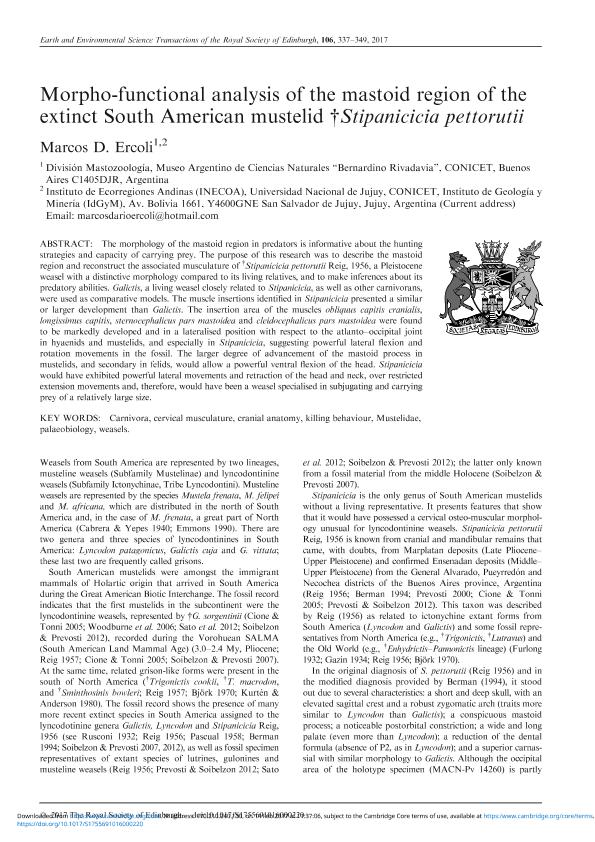Mostrar el registro sencillo del ítem
dc.contributor.author
Ercoli, Marcos Darío

dc.date.available
2018-05-14T14:57:11Z
dc.date.issued
2017-02-06
dc.identifier.citation
Ercoli, Marcos Darío; Morpho-functional analysis of the mastoid region of the extinct South American mustelid †Stipanicicia pettorutii; Royal Society of Edinburgh; Earth and Environmental Science Transactions of the Royal Society of Edinburgh; 106; 4; 6-2-2017; 337-349
dc.identifier.issn
1755-6910
dc.identifier.uri
http://hdl.handle.net/11336/45059
dc.description.abstract
The morphology of the mastoid region in predators is informative about the hunting strategies and capacity of carrying prey. The purpose of this research was to describe the mastoid region and reconstruct the associated musculature of † Stipanicicia pettorutii Reig, 1956, a Pleistocene weasel with a distinctive morphology compared to its living relatives, and to make inferences about its predatory abilities. Galictis, a living weasel closely related to Stipanicicia, as well as other carnivorans, were used as comparative models. The muscle insertions identified in Stipanicicia presented a similar or larger development than Galictis. The insertion area of the muscles obliquus capitis cranialis, longissimus capitis, sternocephalicus pars mastoidea and cleidocephalicus pars mastoidea were found to be markedly developed and in a lateralised position with respect to the atlanto-occipital joint in hyaenids and mustelids, and especially in Stipanicicia, suggesting powerful lateral flexion and rotation movements in the fossil. The larger degree of advancement of the mastoid process in mustelids, and secondary in felids, would allow a powerful ventral flexion of the head. Stipanicicia would have exhibited powerful lateral movements and retraction of the head and neck, over restricted extension movements and, therefore, would have been a weasel specialised in subjugating and carrying prey of a relatively large size.
dc.format
application/pdf
dc.language.iso
eng
dc.publisher
Royal Society of Edinburgh

dc.rights
info:eu-repo/semantics/openAccess
dc.rights.uri
https://creativecommons.org/licenses/by-nc-sa/2.5/ar/
dc.subject
Carnivora
dc.subject
Cervical Musculature
dc.subject
Cranial Anatomy
dc.subject
Killing Behaviour
dc.subject
Mustelidae
dc.subject
Palaeobiology
dc.subject
Weasels
dc.subject.classification
Meteorología y Ciencias Atmosféricas

dc.subject.classification
Ciencias de la Tierra y relacionadas con el Medio Ambiente

dc.subject.classification
CIENCIAS NATURALES Y EXACTAS

dc.title
Morpho-functional analysis of the mastoid region of the extinct South American mustelid †Stipanicicia pettorutii
dc.type
info:eu-repo/semantics/article
dc.type
info:ar-repo/semantics/artículo
dc.type
info:eu-repo/semantics/publishedVersion
dc.date.updated
2018-04-24T15:14:00Z
dc.journal.volume
106
dc.journal.number
4
dc.journal.pagination
337-349
dc.journal.pais
Reino Unido

dc.journal.ciudad
Edimburgo
dc.description.fil
Fil: Ercoli, Marcos Darío. Consejo Nacional de Investigaciones Científicas y Técnicas. Oficina de Coordinación Administrativa Parque Centenario. Museo Argentino de Ciencias Naturales ; Argentina. Universidad Nacional de Jujuy. Instituto de Ecorregiones Andinas. Consejo Nacional de Investigaciones Científicas y Técnicas. Centro Científico Tecnológico Conicet - Salta. Instituto de Ecorregiones Andinas; Argentina. Universidad Nacional de Jujuy. Instituto de Geología Minera; Argentina
dc.journal.title
Earth and Environmental Science Transactions of the Royal Society of Edinburgh

dc.relation.alternativeid
info:eu-repo/semantics/altIdentifier/doi/http://dx.doi.org/10.1017/S1755691016000220
dc.relation.alternativeid
info:eu-repo/semantics/altIdentifier/url/https://www.cambridge.org/core/journals/earth-and-environmental-science-transactions-of-royal-society-of-edinburgh/article/morphofunctional-analysis-of-the-mastoid-region-of-the-extinct-south-american-mustelid-stipanicicia-pettorutii/DC832E36E7D3184408A76C58A80E85E9
Archivos asociados
